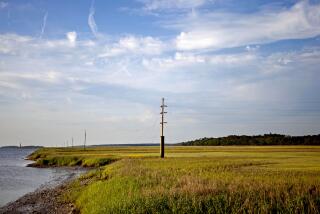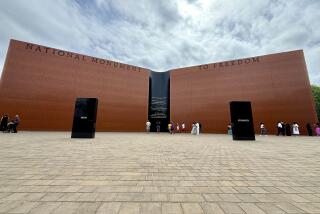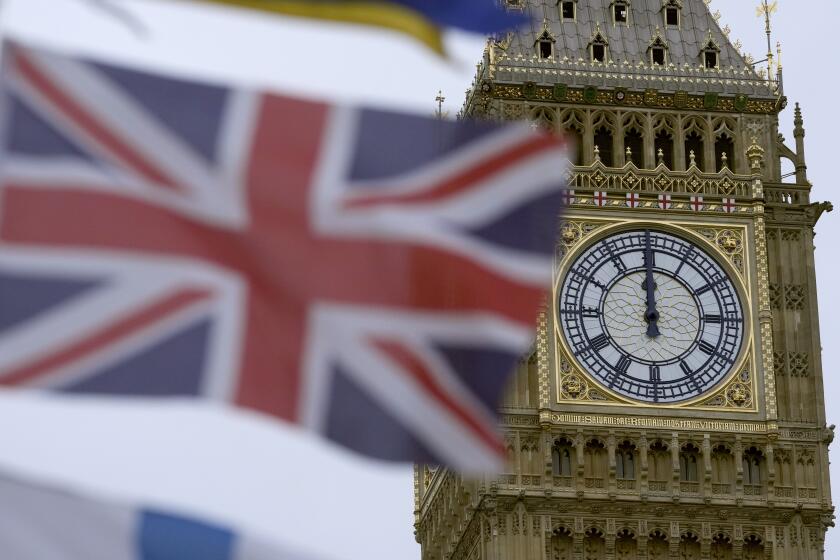Should the Confederate carving on Georgia’s Stone Mountain stay up as a reminder of history?
- Share via
Reporting from STONE MOUNTAIN, Ga. — Most postcards of the huge granite outcropping that rises abruptly on the outskirts of Atlanta dwell on one section: a vast carving of three giants of the Confederacy — Jefferson Davis, Robert E. Lee and Thomas J. “Stonewall” Jackson — on horseback, clasping their hats to their chests.
It is the largest and most ambitious memorial to the South’s “Lost Cause” — a monument that took nearly half a century to complete.
Yet clamber up the mammoth gray rock, past the row of Confederate battle flags at the foot of a mile-long walk-up trail, and an altogether different Stone Mountain emerges.
Thousands of visitors — black and white and many shades in between — scale the 825-foot-tall monolith each day, hiking up the mountain’s west side, sheltering under the shade of loblolly pines. From this vantage point, the carving is out of sight — and, for most hikers, out of mind.
On a recent morning, an African American woman, exhausted after a long trudge up and down, approached a white Jewish man to ask whether he could help find keys she had left at the top. A South Korean couple paused every few minutes to snap pictures. A Jamaican man lingered near the half-way point, smiling as he leaned his wooden walking stick against a waist-high boulder.
-------------
FOR THE RECORD
4:20 p.m., Aug. 2: This article says Shannon Byrne “would like to see the carving demolished.” Although Byrne said that she would be happy with the carving’s removal, she did not use the word “demolished” and has not campaigned for its demolition.
-------------
At the summit, a swarm of ethnicities and nationalities mingled in bright tank tops and tight Lycra, dark hijabs and billowing saris.
Over the years, Stone Mountain has become a multicultural mecca of the new South, a place where people from all over come to work out, meditate, picnic and gaze at the sprawling Atlanta skyline below.
“Every day, I enjoy the freedom that those before me didn’t have,” said Regina Boyd, 33, an African American clinical researcher who climbs the trail almost every day before work, Beyonce blasting through her earphones. “I feel like I’ve been to the mountain top and I’ve seen the promised land.”
While Boyd was growing up, her great-grandmother warned her never to set foot on Stone Mountain. The rock was the site of the rebirth of the Ku Klux Klan in 1915, when 16 men climbed to the summit on Thanksgiving eve and set fire to a crude wooden cross. Klansmen in white robes met atop the mountain for decades.
Yet when Boyd reaches the rock’s curved peak, she thinks of the Rev. Martin Luther King Jr.’s 1963 “I have a dream” speech.
“Let freedom ring from Stone Mountain of Georgia,” he said.
African American activists have long called for the Confederate flags here to be taken down. This month, amid mounting scrutiny of Confederate symbols after the massacre in June of nine black parishioners in Charleston, S.C., an NAACP leader went further, calling for the sculpture to be sandblasted.
Though the park’s memorial status is protected by Georgia law, some have suggested the carving — the largest bas relief sculpture in the world, bigger than Mt. Rushmore — be tweaked to offer a more balanced interpretation of history. This month, the Atlanta City Council passed a resolution asking Gov. Nathan Deal to appoint a study group to consider adding other significant local figures, such as King and President Jimmy Carter.
The carving of the rock began in 1923, after the United Daughters of the Confederacy commissioned Gutzon Borglum, the sculptor who went on to work on Mt. Rushmore. Back then, the rock sat on land owned by a Klan sympathizer, whose son later became an Imperial Wizard of the National Knights of the Klan.
Yet Borglum quit the project after a disagreement, and the next sculptor took three years just to complete Lee’s head. The carving was abandoned for nearly three decades, until the State of Georgia purchased the land in 1958, forming the Stone Mountain Memorial Assn. to oversee the monument’s completion. The sculpture — so large that Lee’s figure is the size of a nine-story building — was not finished until 1972.
Since then the small railroad town below the rock has undergone a demographic change. The city’s African American population jumped from 13% in 1980 to 75% in 2010. In 1997, the city elected its first African American mayor.
A few miles away, the neighboring town of Clarkston, a refugee resettlement hub since the 1990s, has become one of the most diverse small towns in the nation, home to a burgeoning population of residents from as far away as Somalia, Bosnia, Iraq and Bhutan.
“The whole world comes to the mountain and they don’t particularly care about the Confederacy,” said Shannon Byrne, 40, a 1993 graduate of Stone Mountain High School. In recent years she has worked on a blog, “I am the Mountain,” which chronicles hikers’ stories and focuses on the rock as a “stunning ethnic mosaic.” She would like to see the carving demolished.
Siraaj Rhett, 32, an African American with Cherokee ancestry who strode along Robert E. Lee Boulevard with rapper DMX pounding through his earbuds, said he had no problem with the sculpture. Americans, he said, were going too far in erasing history and homogenizing the American experience.
“It should definitely stay up as a reminder of history,” he said. “Not all history is good, but removing all these symbols, making them taboo, is hurting race relations and creating more tension.”
Toni McCoy, 52, a black software engineer, said she appreciated the artistry of the carving.
“It’s not offensive at all,” she said. “All of this is history, and history can’t be replaced or wiped out. It’s better that we focus on changing the future.”
Some at Stone Mountain say the state park has already gone too far in erasing historical symbols.
After touring a gift shop at the base of the mountain with his wife and son, Brian Higdon, 48, a white maintenance technician from Birmingham, Ala., was riled to find glass paperweights depicting Ulysses S. Grant and Abraham Lincoln, but nothing of Confederate leaders.
“Here we are in the South, at Stone Mountain Park, and we can’t even find Robert E. Lee,” Higdon said, seething. “When is enough enough?”
Over the years, park officials have gradually downplayed the Confederacy. Park gift shops have expunged the rebel battle flag from playing cards and children’s jigsaw puzzles. The Confederate Hall museum, which once displayed military artifacts and sculptures, now focuses on the mountain’s geology.
Even the once gung-ho celebration of Southern pride, the Stone Mountain Lasershow Spectacular, a nightly summertime extravaganza that projects digital lasers on the mountainside, has evolved: It now superimposes an image of King, who invoked the mountain so long ago, on the rock face.
Jarvie is a special correspondent.
ALSO:
NAACP wants Confederate carving removed from Georgia’s Stone Mountain
Confederate flag is coming down in South Carolina; battles go on elsewhere
Black Caucus members seek name change for city of Fort Bragg
More to Read
Sign up for Essential California
The most important California stories and recommendations in your inbox every morning.
You may occasionally receive promotional content from the Los Angeles Times.











